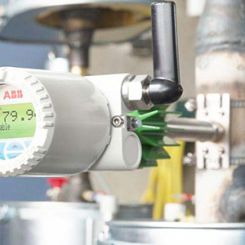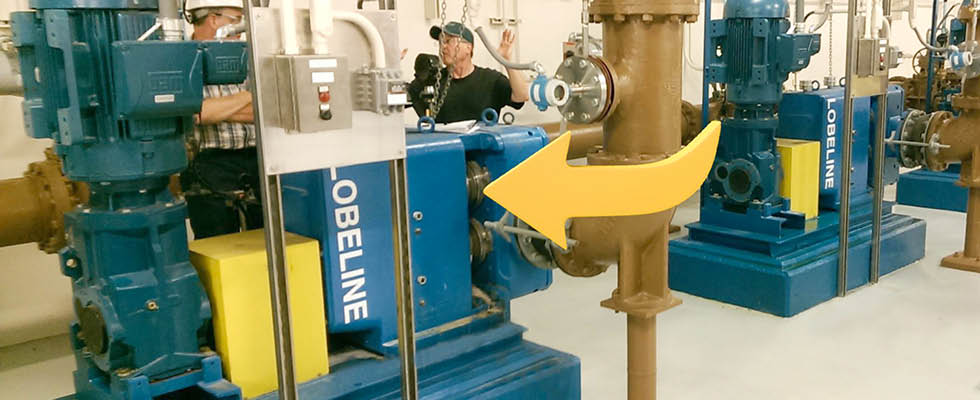
In the municipal wastewater world, sludge and cake often pose demanding challenges for pumps. Municipal wastewater treatment plants handle sludge in thickening processes; aerobic and anaerobic digestion; fat, oil and grease (FOG) and other applications.
Whether it is dewatered biosolids or different sludge media, the goal is the same: moving product efficiently from point A to point B while maximizing pump longevity, minimizing energy use and reducing maintenance downtime. It is also crucial to understand the terms “cake” and “sludge” and their percentage of solids. Sludge is usually defined as 1%-12% solids, while cake ranges from 8% to approximately 45%.
Two of the most popular pumps used to get this job done in the municipal industry are the progressive cavity pump and the lobe-style rotary pump. Both fall under the category of positive displacement pumps and have proven to check the box time and time again. For moving viscous and abrasive media, these two pumps offer a solid approach. This article will cover their history, mechanics, strengths and weaknesses to help users evaluate the best solution for their process.
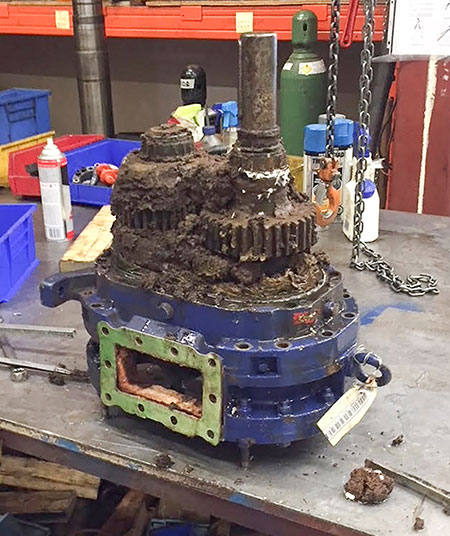
Progressive Cavity Pumps
Developed in the 1930s, progressive cavity (PC) pumps are single screw with a helical rotor that turns eccentrically inside a double-helix stator. The stators are typically made of rubber. Together, the rotor and the stator create an interference fit of a series of sealed cavities that can move within each other. These cavities progress from the suction side of the pump to the discharge side, creating a smooth, pulsation-free flow—rendering the PC pump ideal for thick, abrasive, shear-sensitive fluid. Each cavity only handles the pressure from the adjacent cavity, distributing the pressure across the full length of the pump. This lowers the internal stress, making volume discharge highly consistent.
Notable capabilities include:
- Handling viscosities up to 1 million centipoise (cP)
- Discharge pressures up to 700 pounds per square inch (psi)
- Flow capacities up to 3,750 gallons per minute (gpm)
- Solids handling up to 45%
- Minimum flow change based on pressure and percentage of solids
- No pulsation dampeners required
- Quiet operation
- Fully reversible flow (key for clearing blockages)
As for the cons of PC pumps, they cannot run dry for longer than a few minutes during startup in sludge or cake applications. It is essential that lubrication (especially at startup) is conducted appropriately, or users can shorten the pump’s life exponentially. Abrasive particles like grit or struvite in municipal sludge can rapidly wear down key components such as rotors and stators, especially if users are not managing the speed appropriately. As a rule, abrasion is proportional to speed, so minimizing the rotations per minute (rpm) can significantly extend equipment life.
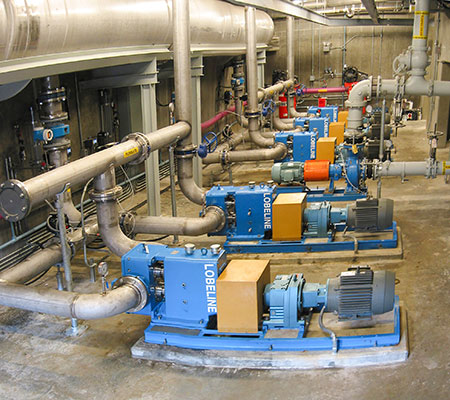

Rotary Lobe Pumps
The lobe-style pump was developed in the 1860s and was originally a design for an air compressor. The technology is quite simple: This positive displacement pump utilizes synchronized lobes on parallel shafts (Image 2). The lobes intermesh and rotate without contacting each other inside a casing and trap the fluid, displacing it through the pump from inlet to discharge.
Rotary lobe pumps can handle a wide range of media, including sludge, slurries and noncompressible solids. These pumps are widely used in the food and beverage markets, pharmaceuticals, some chemical plants and, of course, the wastewater industry—primarily for moving biosolids.
Key advantages include:
- Flow rates over 6,000 gpm
- Pressures up to 150 psi
- Solids handling up to 12%
- Dry-run capability (seal protection or flush water)
- Bidirectional flow
- Front pull-out design for easy maintenance
- Compact footprint and flexible mounting options
Rotary lobe pumps with the longest time between failures and lowest maintenance costs feature an air gap between the rotor housing and gear case (Image 3). This isolates the drive components in the event of a wet-end seal failure.
Manufacturers have utilized new modern materials of construction to adapt to specific applications, allowing end users to “build a better mousetrap” to address specific chemical or abrasive profiles in their media. Rotors are available in several metallic options like carbon steel and stainless steel, as well as various elastomeric compounds.
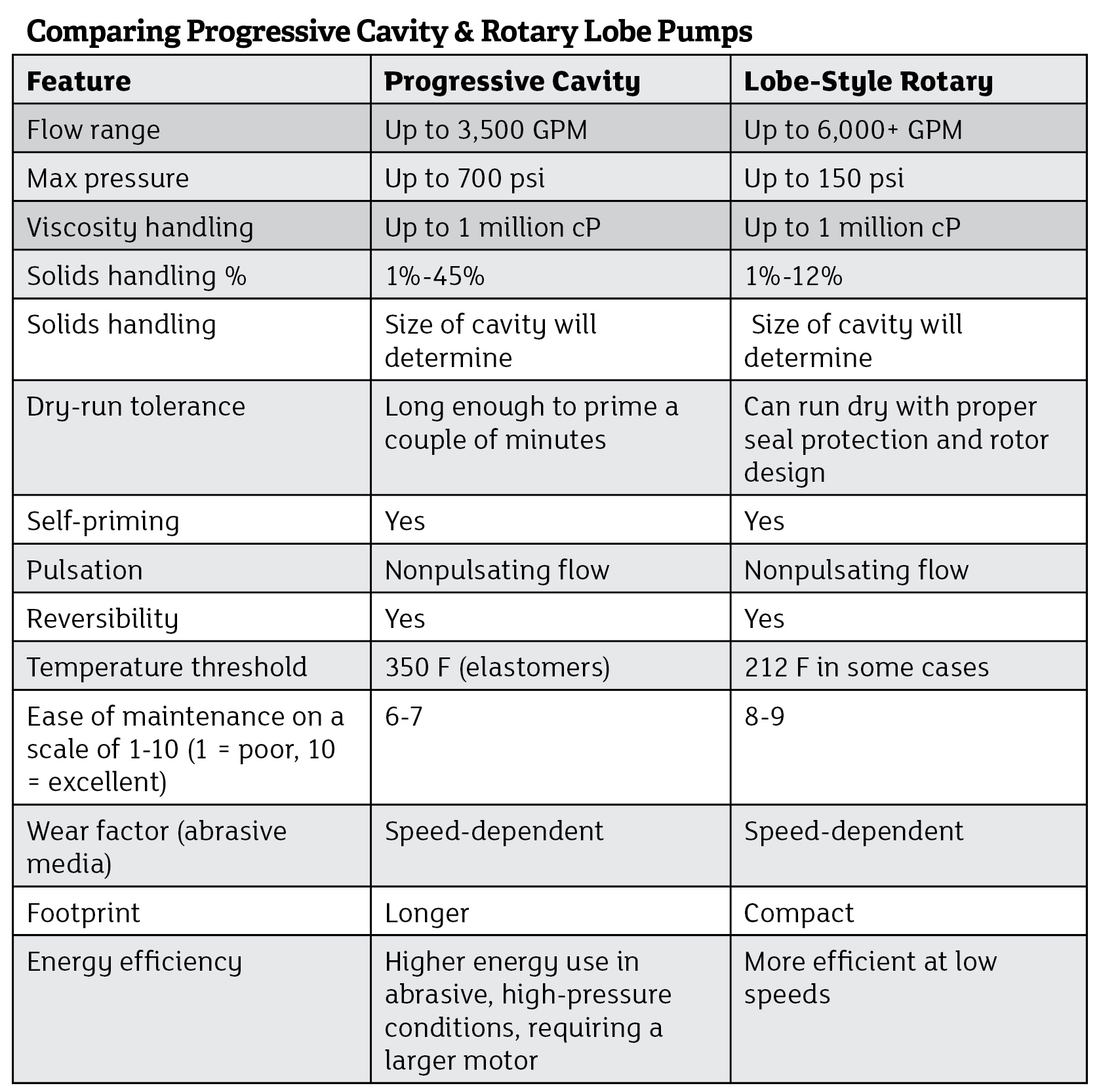
Maintenance: PC Pumps
Maintenance on a PC pump can be time-consuming. Because the stators fit tightly around the rotor, replacement usually requires pulling the pump offline and completely disassembling it. However, manufacturers have recently developed split stators, which speed up the process. Stators are the most common wear component by far and are usually replaced at a frequency of three for every one rotor. Other internal parts are the connecting rods and universal joints, and they are typically replaced at the same time as the rotors.
Seal failures are common in abrasive or corrosive applications, which can be costly if not caught early. It is important to have the right elastomer in an application. Users should take into consideration swelling in the elastomers when dealing with variable flows and potential high-temperature environments. Getting the durometer correct on a rubber stator is crucial for long-term durability.
Maintenance: Lobe Pumps
Wear components, such as the rotors, seals and wear plates, are accessible through the front cover of a lobe pump. This procedure allows the pump to be serviced in place without disconnecting from piping or the drive coupling. Other wear items include the rear wear plates, mechanical seals and bearings. Timing gears usually need retiming during an overhaul.
Newer designs featuring cartridge-style mechanical seals that can be replaced without disturbing the rotor housing. Splined shafts are another new technology that allows longer runtime, reducing stress and eliminating keyway failures seen in older technology.
Applications & Real-World Performance
Field experience with PC pumps varies greatly. Some technicians report near-flawless operation with either style and can demonstrate intense loyalty to one technology, or even a specific brand, while another plant in the same district will report constant failures with the exact same equipment. It all comes down to properly assessing the specific needs of the application and taking into consideration all parameters including pressure, flow rate, solids content, abrasives, pH, organics, FOG, temperature and others.
The truth is that success depends on correctly sizing the pump and matching it to the application. Improper sizing for the potential pressure and temperature solids handling increases the risk of premature failure. Likewise, if the speed and startup control are not handled properly, premature failure can ensue. Other considerations include runtime, redundancy, duty cycle and scheduled preventive maintenance.
Making a Final Decision
Both pumps are equipped to perform in cake and sludge transfer applications, but neither is perfect. An evaluation of process and other internal factors will help lead to a decision. Things to consider:
- Available space
- Flow and pressure requirements
- Dry-running potential
- Maintenance experience with either technology
If the application requires the following, the PC pump may be the best bet:
- High pressure
- Ultra-high viscosity
- High percentage of solids
- High temperature
However, if a user’s priorities include any of the below factors, the lobe-style pump, especially with advances in straight-lobe technology, will likely be the better option:
- Compact design
- Ease of maintenance
- Dry-run capability
- Handling oversized noncompressible solids
Experience has proven that the application will determine the best fit, form and function. The keys to success are knowing the media and the application’s environment and working with qualified subject matter experts. Partnering with a trusted engineering or supply professional will help lead to a successful installation.
For more on progressive cavity pumps, visit pumpsandsystems.com/tags/progressive-cavity-pumps.
For more on rotary lobe pumps, visit pumpsandsystems.com/tags/rotary-lobe-pumps.

